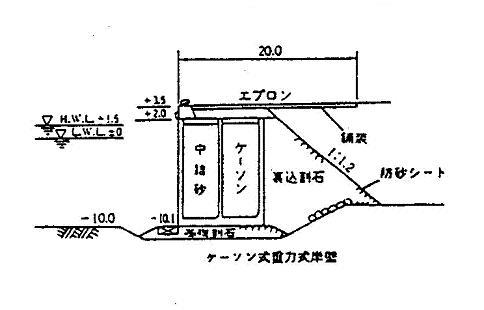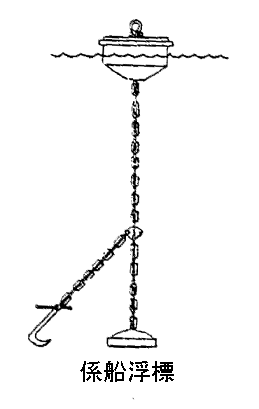- Yokohama-shi Top Page
- Business
- Menu by field
- Harbor
- Port Business Glossary
- Port Business Glossary -
Here's the text.
Port Business Glossary -
Last Updated August 5, 2024
A B C D E F G H I J K L M N O P Q R S T U V W X Y Z
-Ah- -- -- -- -- -- -- -- - La- --wa-
--
- caisson
- A box-shaped or cylindrical structure mainly made of reinforced concrete. After being made on the ground in advance, sinking in water or soil, it is installed, and then stabilized by putting concrete, sand, etc. .

- Gate
- The entrance of the container terminal. Check the ship name, destination, container appearance, container number, and seal number.
- Gateway
- At the entrance of the container terminal, when loading and unloading the actual container, check the weight measurement of the container, truck land transportation, etc.
- Gate open
- Opening the entrance of the container terminal
- Gate close
- The entrance of the container terminal must be closed
- Care mark
- Refers to the handling instruction mark indicated to prevent damage to cargo.
- Landscape Act
- In order to promote the formation of good landscapes in Japan's cities, Noyama fishing villages, etc., by formulating landscape plans and taking other measures comprehensively, the formation of beautiful and stately national land and the creation of a rich and rich living environment And a law that aims to realize a unique and vibrant community, thereby contributing to the improvement of people's lives and the sound development of the national economy and local communities.
- (Connecting) ship pit
- →Dolphin
- (Connecting) Ship Pole
- →Bit, borard
- (Connecting) Ship buoy (mooring)
- There are two types of buoys, one that is used as a route sign for the safety of navigation of ships and one that is used for mooring ships. The latter is called a mooring ship.

- (Connecting) Replacement Facility (mooring facility)
- A facility that connects ships, and refers to quays, mooring boats, mooring pits, Sanbashi, Ukisanbashi, landing sites and Funa Ageba.
- Genome
- In 1920, German plant geneticist H. A term proposed by Vincler, it refers to the whole of genetic information currently present in the cells of living organisms. It contains genes and information that controls the expression of genes.
- Chemical tanker (chemical tanker)
- A tanker that further enhances the product career and transports a large amount of chemical products in liquid form.
- Quarantine (Quarantine)
- The crew of ships entering the port from abroad must have a coastal plague based on the Quarantine Act. In principle, ships arriving from a foreign country cannot land or unload goods from that ship unless they have been issued a “quarantine certificate” or “temporary quarantine certificate” by a quarantine officer. In addition, quarantine is required by the Plant Protection Act when importing plants, and in the case of animals, by the Livestock Infectious Disease Prevention Act. The Ministry of Health and Welfare and the Ministry of Agriculture, Forestry and Fisheries have established quarantine stations nationwide for the purpose of preventing diseases and pests and ensuring the safety of agricultural production. The Yokohama Quarantine Station has been set up in Yokohama.
- Detection (measurement)
- For import and export goods, the number, weight, degree of damage, etc. of the goods on behalf of the import and exporter, and the person engaged in the inspection work is called a inspector and is also called a Tallyman or a checker. → Taryman
- Inspection business
- This is a business that calculates the number of cargo when loading or unloading loaded cargo, or proves delivery, and requires a license from the Minister of Land, Infrastructure, Transport and Tourism. Representative public interest corporations include the Japan Freight Prosecutors Association and the Nippon Public Prosecutors Office. Class 5 business.
- Certification business
- The appraisal business and the inspection business are collectively referred to as the certification business.
- Shared ships
- A ship with a structure that can carry several kinds of cargo. It has the following characteristics. (1)Depending on the market conditions, cargo with higher fares can be loaded. (2)It is possible to reduce voyages. However, construction costs are more expensive compared to dedicated ships.
- Inspection business
- This is a business that calculates or proves the volume or weight of the cargo when loading or unloading loaded cargo, and requires a license from the Minister of Land, Infrastructure, Transport and Tourism. There are many businesses that also serve as appraisal business. Class 7 business.
- Keihin Port
- Refers to Tokyo Port, Yokohama Port, and Kawasaki Port in Tokyo Bay. Under the Port and Harbor Law, each local government is the port manager, but under the Port Law, it is treated as a Keihin Port.
- Construction soil
- Surplus soil generated from construction work. In the past, it was called "remaining soil" because disposal was mainly used, but due to the recent increase in awareness of recycling, from the viewpoint of reusing surplus soil between construction as much as possible, it is called "construction-generated soil". It came to be called. Of the construction generated soil generated from city public works, etc., most of which could not be reused between constructions are used as landfills for Minamihonmoku Pier Reclaimed Land.
Inquiries to this page
Port and Harbor Bureau General Affairs Department General Affairs Division
Telephone: 045-671-2880
Telephone: 045-671-2880
Fax: 045-671-7158
Email address: kw-somu@city.yokohama.jp
Page ID: 666-915-068







